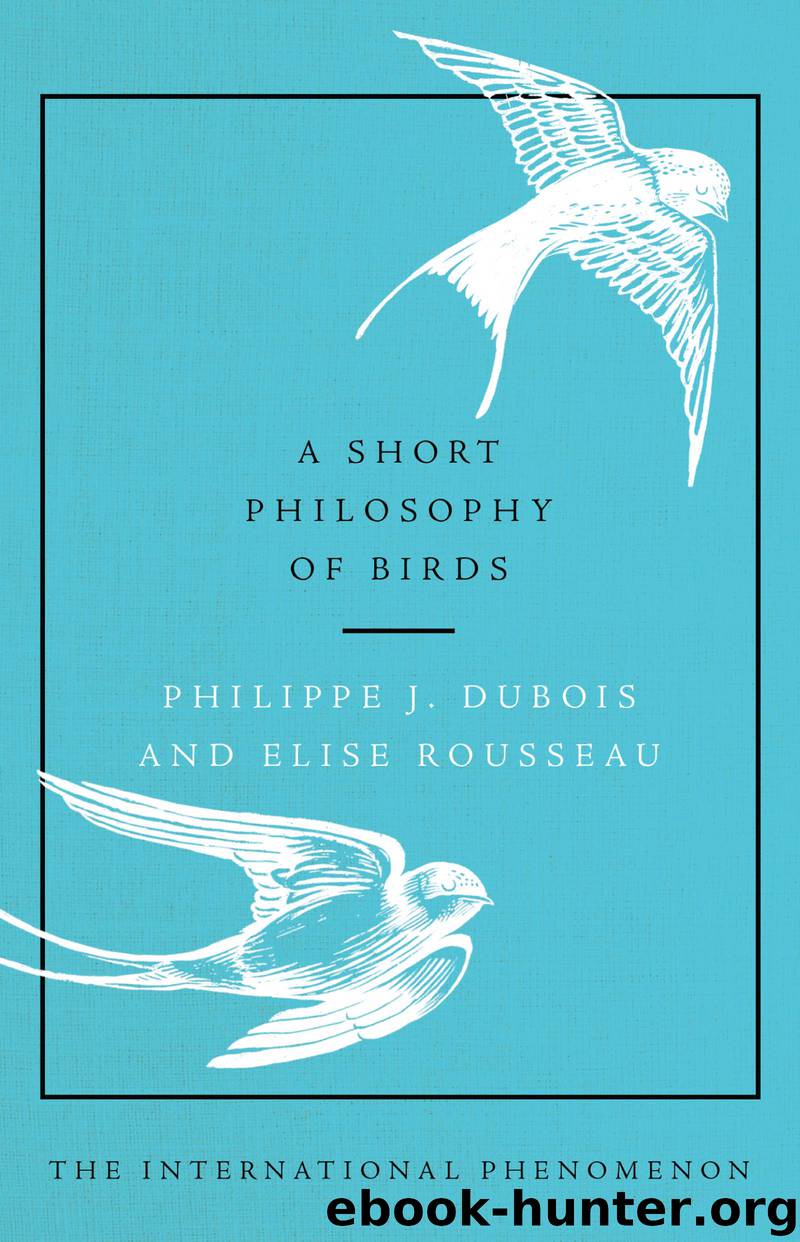A Short Philosophy of Birds by Philippe J. Dubois

Author:Philippe J. Dubois
Language: eng
Format: epub
Publisher: HarperCollins
Published: 2019-08-13T16:00:00+00:00
12.
Did Curiosity Kill the . . . Bird?
The Audacity of the Robin
FROM BIRTH TO DEATH, a bird’s life is one long series of risks. Flying, finding food, reproducing, raising young: everything is dangerous. Without risk, though, there is no life, and some birds’ natural curiosity may lead them to take risks but also to discover new possibilities: rich food sources, perfect nest locations or ideal places to rest in safety. He who dares, wins, and for animals, especially birds, curiosity is an effective and often sophisticated way of adapting to the environment. It is therefore also an essential tool for survival.
Take the robin, a familiar bird to all gardeners in Western Europe, and one that is especially fearless. The robin will perch calmly on a chair, a spade or any other man-made object within just a few centimetres of a person, to observe them at work. Head tilted and beady eyed, it sits completely still and seems to watch with interest and curiosity. As soon as the rake turns up a worm, the robin pounces and gobbles it up. Then it waits for the next one, its red breast puffed up, seemingly unafraid of the gigantic human being at work next to it.
Originally, the robin was a woodland species that kept its distance from humans. It has always been known for its habit of following mammals such as deer or boar while they graze or dig, and it sometimes gets quite literally under their feet, always with its head on one side and its gleaming eyes watchful. It hops along, following the animal: just like in the garden, it’s on the lookout for small insects unearthed by a hoof or snout.
The robin continues to be a woodland bird but is often found at the woodland’s edge, close to human habitation. Over time it has gradually come closer and closer to people, to the point of following them around the garden. The robin’s curious, opportunistic nature is especially noticeable in Great Britain, where it has become part of popular mythology and is a familiar image on Christmas cards. The widespread British habit of feeding birds in winter has probably contributed to reducing the robin’s reticence but has also made it one of the main victims of cats. This fearlessness is much less pronounced in countries where the robin is hunted (such as Southern Europe) or where it remains a largely woodland bird (in Eastern Europe). In these places it remains timid and wary.
The robin’s curiosity has certainly allowed it to broaden its diet and extend its territory, most notably into urban gardens where the winter is less harsh than it is in the countryside. An urban robin thus has a greater chance of surviving a cold winter than a woodland robin.
A naturally curious nature has brought other species into closer contact with people. We’ve all seen pictures of sparrows in Paris, blue tits in London, and even jays in American National Parks, coming to eat out of people’s hands. These wild birds have lost all fear of humans.
Download
This site does not store any files on its server. We only index and link to content provided by other sites. Please contact the content providers to delete copyright contents if any and email us, we'll remove relevant links or contents immediately.
Sapiens: A Brief History of Humankind by Yuval Noah Harari(13038)
The Tidewater Tales by John Barth(12026)
Do No Harm Stories of Life, Death and Brain Surgery by Henry Marsh(6332)
Mastermind: How to Think Like Sherlock Holmes by Maria Konnikova(6225)
The Thirst by Nesbo Jo(5778)
Why We Sleep: Unlocking the Power of Sleep and Dreams by Matthew Walker(5637)
Sapiens by Yuval Noah Harari(4529)
Life 3.0: Being Human in the Age of Artificial Intelligence by Tegmark Max(4492)
The Longevity Diet by Valter Longo(4444)
The Rules Do Not Apply by Ariel Levy(3897)
The Immortal Life of Henrietta Lacks by Rebecca Skloot(3820)
The Body: A Guide for Occupants by Bill Bryson(3789)
Why We Sleep by Matthew Walker(3767)
Animal Frequency by Melissa Alvarez(3750)
Yoga Anatomy by Kaminoff Leslie(3696)
Barron's AP Biology by Goldberg M.S. Deborah T(3628)
The Hacking of the American Mind by Robert H. Lustig(3575)
All Creatures Great and Small by James Herriot(3506)
Yoga Anatomy by Leslie Kaminoff & Amy Matthews(3392)
